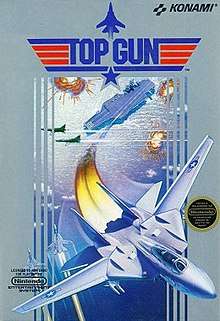Top Gun (1987 video game)
Top Gun is a shoot 'em up combat flight simulation game based on the film of the same name. It was developed and published by Konami, and released for the Nintendo Entertainment System (NES).[1] It was released in the United States in November 1987,[2] and was subsequently released in Europe.[3][4][5] The game is an adaptation of Vs. Top Gun, a 1987 Nintendo VS. System arcade game also by Konami.[6][7]
| Top Gun | |
|---|---|
 | |
| Developer(s) | Konami |
| Publisher(s) | Konami |
| Series | Top Gun |
| Platform(s) | Nintendo VS. System, NES |
| Release | 1987 |
| Genre(s) | Shoot 'em up, combat flight simulation |
| Mode(s) | Single-player |
Gameplay
Top Gun is a shoot 'em up combat flight simulation game,[7][3][8] viewed from a first-person perspective inside the cockpit of an F-14 fighter plane.[1] The game is based on the film of the same name, and is played across four levels, each one involving the player fighting off enemy MiGs. In the second level, the player must also destroy an enemy aircraft carrier. For the final two levels respectively, the player's target is an enemy fortress and a satellite base in outer space. The player has three lives in the form of F-14 planes. The game does not include a "continue" option in the event that all three planes have been destroyed.[1][7][3][9]
The player has unlimited machine gun ammunition and three different types of missile, each one with their own advantages. MiGs also have their own missiles, which the player must avoid or destroy. The player is presented with onscreen information such as altitude, air speed, a radar, and a fuel gauge. Once during each level, the player can call in a tanker plane to refuel the F-14 if necessary. Refueling is done in mid-air, and the player must align the F-14 with the fuel pump. After each level, the player must successfully land the F-14 on a U.S. aircraft carrier. If the landing fails, then a plane is lost and the player must try again.[1][7][3][9]
Reception
| NES reviews | ||||||||||||||||||
|---|---|---|---|---|---|---|---|---|---|---|---|---|---|---|---|---|---|---|
| ||||||||||||||||||
Top Gun sold two million copies.[10] Eugene Lacey of Computer and Video Games praised the graphics and sound, and was surprised by "the level of sophistication that the designers have achieved" with the gameplay considering the limited number of buttons on the NES controller. Lacey called it an "excellent" flight game addition to the NES library of games.[3] The Games Machine stated that like most NES games, Top Gun had an emphasis on playability rather than graphical presentation. The magazine described the graphics as "little more than a detailed cockpit and fast moving enemies," but stated that the game succeeded in playability with its levels. The Games Machine added that the landing and refueling segments, as well as the necessary missile strategy, help to "spruce up the action."[9]
Steve Jarratt of ACE praised the sound effects and wrote that Top Gun "is visually sparse but the sprites are extremely effective – especially in the air-to-air combat." Jarratt praised the large amount of "varied and entertaining" action, and stated that the game would appeal to fans of shoot 'em up games.[7] German magazine Power Play criticized the gameplay, believing there was a lack of playful variety.[5] Ulrich Mühl of Aktueller Software Markt praised the graphics and sound.[11] French magazine Player One praised the graphics, stating that they were good for an NES game.[4]
Total! reviewed the game in 1993, and considered the gameplay too simplistic. The magazine stated that the levels played similarly to each other, but wrote that the landing and refueling segments added variety to the game. The magazine noted the limited number of levels and concluded, "While Top Gun's a fun blast, it hasn't got any lasting pull."[8] In a later review for the website AllGame, Christopher Michael Baker praised the graphics and realistic sound effects, and stated that Top Gun was arguably the best air warfare game ever released for the NES. However, Baker stated that despite the game's realism, it also offered much frustration with its difficulty. Baker cited three primary reasons for the difficulty, including the split-second decisions required in determining whether to avoid or destroy missiles, and the lack of continues. Baker also cited the landing and refueling segments, writing that they require "a soft touch and total concentration," and that they are "difficult, if not impossible, to master."[1]
References
- Baker, Christopher Michael. "Top Gun review". AllGame. Archived from the original on November 16, 2014. Retrieved January 13, 2020.
- "NES Games" (PDF). Nintendo. p. 13. Archived from the original (PDF) on September 21, 2008. Retrieved January 13, 2020.
- Lacey, Eugene (January 1989). "Top Gun". Computer and Video Games. United Kingdom. p. 142.
- "Top Gun". Player One (in French). France. September 1990. p. 56.
- "Top Gun". Power Play (in German). Germany. May 1988. p. 92.
- "Vs. Top Gun". arcade-museum.com. Retrieved January 13, 2020.
- Jarratt, Steve (March 1989). "Top Gun: Tom Cruise simulator from Konami". ACE. United Kingdom. p. 61.
- "NES Round-Up: Top Gun". Total!. United Kingdom. February 1993. p. 56.
- "Top Gun". The Games Machine. United Kingdom. March 1989. p. 42.
- Sheff, David (1999). Game Over: How Nintendo Conquered the World. GamePress. p. 217. ISBN 978-0-9669617-0-6. Retrieved January 13, 2020.
- Mühl, Ulrich (January 1989). "Es ,,burnert" auf dem Nintendo". Aktueller Software Markt (in German). Germany. pp. 72–73.